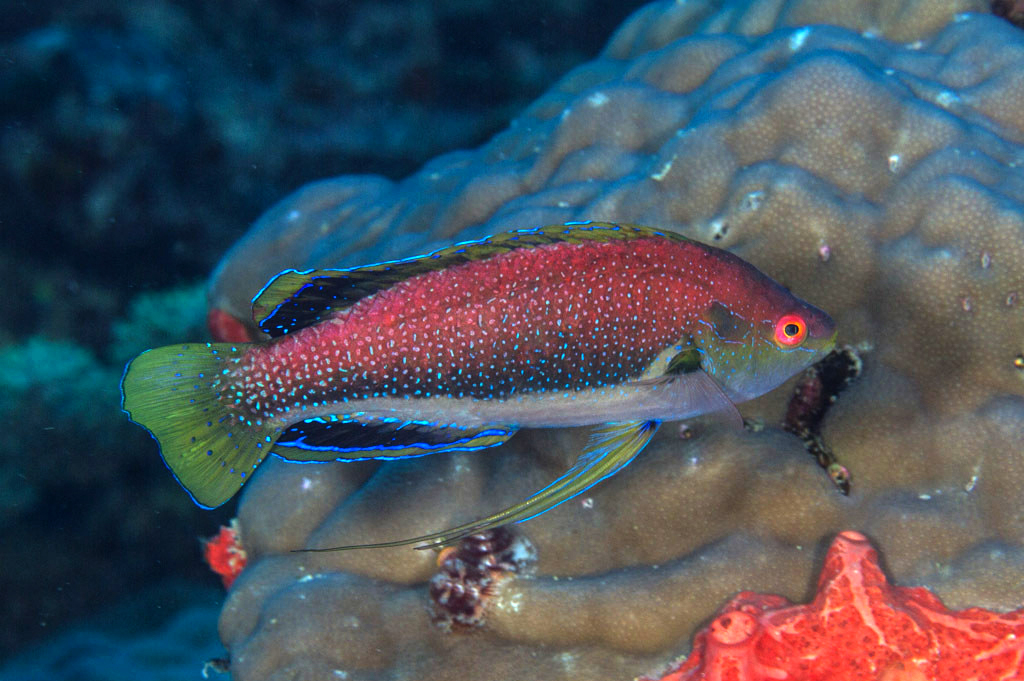Finespot Wrasse, Cirrhilabrus punctatus Randall & Kuiter 1989
Other Names: Black-finned Wrasse, Dotted Wrasse, Fine-spotted Fairy-wrasse, Fine-spotted Wrasse, Small-spotted Wrasse

A male Finespot Wrasse, Cirrhilabrus punctatus, at Tailevu, Fiji. Source: Mark Rosenstein / iNaturalist. License: CC BY Attribution-Noncommercial-ShareAlike
Summary:
A reddish-brown to dark greyish fairy wrasse with pink to blue dots, an abruptly white to pale pinkish lower fourth, and a black spot or bar on the pectoral-fin base. Females and juveniles have a black spot at the upper caudal-fin base. Adults have a broad red submarginal stripe; males have a black basal stripe on the dorsal and anal fins, and very long pectoral fins; females have a blackish spot anteriorly on the dorsal fin.
Cite this page as:
Bray, D.J. 2025, Cirrhilabrus punctatus in Fishes of Australia, accessed 27 Jun 2025, https://fishesofaustralia.net.au/Home/species/2274
Finespot Wrasse, Cirrhilabrus punctatus Randall & Kuiter 1989
More Info
|
Distribution |
Torres Strait, Queensland and reefs in the Coral Sea, to at least Jervis Bay, with juveniles as far south as Montague Island, New South Wales; also the Lord Howe Province in the Tasman Sea. Elsewhere the species occurs in the southwest Pacific: Papua New Guinea, east to Fiji and Tonga. |
|
Features |
Dorsal fin XI, 9; Anal fin III, 9; Pectoral fin 14-16; Predorsal scales (median) 5-7; Cheek sale rows 2. Lower cheek scale row close to ventral margin of preopercle; pelvic fins in male very long, often half or more of standard length; caudal fin rounded. |
|
Feeding |
Feed on zooplankton in the water column. |
|
Fisheries |
All Cirrhilabrus species are protogynous hermaphrodites, whereby most individuals begin life as females, and are capable of changing sex to become male during their lifecycle. They form small aggregations comprising a dominant male and several females and initial phase males. The dominant male is larger and more colorful than the females and usually displays vibrant colors during courtship. |
|
Etymology |
The specific name is from the Latin punctatus (= spotted), in reference to the numerous pale dots on the head and body of both males and females. |
|
Species Citation |
Cirrhilabrus punctatus Randall & Kuiter 1989, Revue Française d'Aquariologie et Herpétologie 16(2): 44, figs 1-7. Type locality: One Tree Island, Great Barrier Reef, 2 m. |
|
Author |
Bray, D.J. 2025 |
|
Resources |
Finespot Wrasse, Cirrhilabrus punctatus Randall & Kuiter 1989
References
Allen, G.R. 1997. Marine Fishes of Tropical Australia and South-east Asia. Perth : Western Australian Museum 292 pp. 106 pls.
Allen, G.R., Hoese, D.F., Paxton, J.R., Randall, J.E., Russell, B.C., Starck, W.A., Talbot, F.H. & Whitley, G.P. 1976. Annotated checklist of the fishes of Lord Howe Island. Records of the Australian Museum 30(15): 365-454 figs 1-2
Allen, G.R. & Erdmann, M.V. 2012. Reef fishes of the East Indies. Perth : Tropical Reef Research 3 vols, 1260 pp.
Choat, J.H., van Herwerden, L., Robbins, W.D., Hobbs, J.P. & Ayling, A.M. 2006. A report on the ecological surveys undertaken at Middleton and Elizabeth Reefs, February 2006. Report by James Cook University to the Department of the Environment and Heritage. 65 pp.
Francis, M. 1993. Checklist of the coastal fishes of Lord Howe, Norfolk, and Kermadec Islands, southwest Pacific Ocean. Pacific Science 47(2): 136-170 figs 1-2
Hutchins, J.B. & Swainston, R. 1986. Sea Fishes of Southern Australia. Complete field guide for anglers and divers. Perth : Swainston Publishing 180 pp.
Johnson, J.W. 2010. Fishes of the Moreton Bay Marine Park and adjacent continental shelf waters, Queensland, Australia. pp. 299-353 in Davie, P.J.F. & Phillips, J.A. Proceedings of the Thirteenth International Marine Biological Workshop, The Marine Fauna and Flora of Moreton Bay. Memoirs of the Queensland Museum 54(3)
Kuiter, R.H. 1993. Coastal Fishes of South-eastern Australia. Bathurst : Crawford House Press 437 pp.
Kuiter, R.H. 1996. Guide to Sea Fishes of Australia. A comprehensive reference for divers and fishermen. Sydney, NSW, Australia : New Holland Publishers xvii, 434 pp.
Kuiter, R.H. 2002. Fairy & Rainbow Wrasses and their Relatives. Chorleywood, U.K. : TMC Publishing 207 pp.
Kuiter, R.H. 2010. Labridae fishes: wrasses. Seaford, Victoria, Australia : Aquatic Photographics pp. 398.
Oxley, W.G., Ayling, A.M., Cheal, A.J. & Thompson, A.A. 2003. Marine surveys undertaken in the Coringa-Herald National Nature Reserve, March-April 2003. Townsville : Australian Institute of Marine Science 59 pp.
Oxley, W.G., Emslie, M., Muir, P. & Thompson, A.A. 2004. Marine surveys undertaken in the Lihou Reef National Nature Reserve, March 2004. Townsville : Australian Institute of Marine Science i-vii, 1-67 pp.
Randall, J.E., Allen, G.R. & Steene, R. 1997. Fishes of the Great Barrier Reef and Coral Sea. Bathurst : Crawford House Press 557 pp. figs.
Randall, J.E. & Kuiter, R.H. 1989. Cirrhilabrus punctatus, a new species of labrid fish from the southeastern Pacific. Revue Française d'Aquariologie et Herpétologie 16(2): 43-50
Rocha, L. & Pollard, D. 2010. Cirrhilabrus punctatus. The IUCN Red List of Threatened Species 2010: e.T187769A8626128. https://dx.doi.org/10.2305/IUCN.UK.2010-4.RLTS.T187769A8626128.en. Accessed on 03 February 2025.
Tea, Y.-K., Xu, X., DiBattista, J.D., Lo, N., et al. 2021. Phylogenomic analysis of concatenated ultraconserved elements reveals the recent evolutionary radiation of the fairy wrasses (Teleostei: Labridae: Cirrhilabrus). Systematic Biology 71(1): 1-12 https://doi.org/10.1093/sysbio/syab012









